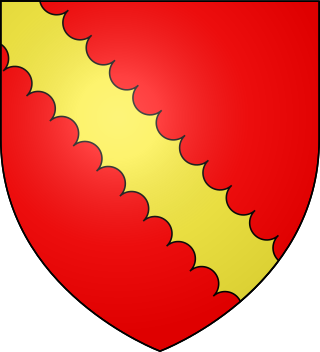
Earl of Pembroke is a title in the Peerage of England that was first created in the 12th century by King Stephen of England. The title, which is associated with Pembroke, Pembrokeshire in West Wales, has been recreated ten times from its original inception. Due to the number of creations of the Earldom, the original seat of Pembroke Castle is no longer attached to the title.

Roger Bigod was 5th Earl of Norfolk.

Duke of Somerset, from the county of Somerset, is a title that has been created five times in the peerage of England. It is particularly associated with two families: the Beauforts, who held the title from the creation of 1448, and the Seymours, from the creation of 1547, in whose name the title is still held. The present dukedom is unique, in that the first holder of the title created it for himself in his capacity of Lord Protector of the Kingdom of England, using a power granted in the will of his nephew King Edward VI.

Earl of Warwick is one of the most prestigious titles in the peerages of the United Kingdom. The title has been created four times in English history, and the name refers to Warwick Castle and the town of Warwick.

Earl of Devon is a title that has been created several times in the Peerage of England. It was possessed first by the Redvers family, and later by the Courtenay family. It is not to be confused with the title of Earl of Devonshire, which is held by the Duke of Devonshire, although the letters patent for the creation of the latter peerages used the same Latin words, Comes Devon(iae). It was a re-invention, if not an actual continuation, of the pre-Conquest office of Ealdorman of Devon.

Earl of Lincoln is a title that has been created eight times in the Peerage of England, most recently in 1572. The title was borne by the Dukes of Newcastle-under-Lyne from 1768 to 1988, until the dukedom became extinct.

Baron Burgh is a title that has been created twice in the Peerage of England.
The title of Baron Grey of Codnor is a title in the peerage of England.

The title of Earl of Ulster has been created six times in the Peerage of Ireland and twice in the Peerage of the United Kingdom. Since 1928, the title has been held by the Duke of Gloucester and is used as a courtesy title by the Duke's eldest son, currently Alexander Windsor, Earl of Ulster. The wife of the Earl of Ulster is known as the Countess of Ulster. Ulster, one of the four traditional provinces of Ireland, consists of nine counties: six of these make up Northern Ireland; the remainder are in the Republic of Ireland.

The office of Lord High Steward of Ireland is a hereditary position of Great Officer of State in the United Kingdom. Currently held by the Earl of Shrewsbury, it is sometimes referred to as the Hereditary Great Seneschal. While most of Ireland achieved independence in 1922, the title retains its original naming and scope rather than adjusting to reflect Northern Ireland as the sole portion of the province of Ulster remaining within the United Kingdom.

Baron Morley was a title in the peerage of England. On 29 December 1299 William Morley, lord of the manor of Morley Saint Botolph in Norfolk, was summoned to Parliament, regarded as the creation of a hereditary barony. At the death of the sixth baron in 1443, the title was inherited by his daughter Eleanor Morley, the wife of Sir William Lovel, who was summoned to parliament as Baron Morley in right of his wife and died in 1476, shortly before her. It was then inherited by their son Henry Lovel, following whose death in 1489 it came to his sister Alice Lovel, who was married to Henry Parker. The title was then held by her descendants in the Parker family until 1697 when, on the death of the fifteenth baron without children, the title came to an end.

Henry Folliott, 1st Baron Folliott (1568–1622) was an English soldier in the Irish army. He fought in the Nine Years' War and then in the suppression of O'Doherty's rebellion at the Siege of Tory Island.

Edward le Despenser, 1st Baron Despenser was the son of another Edward le Despenser and Anne Ferrers, sister of Henry, Lord Ferrers of Groby. He succeeded as Lord of Glamorgan in 1349.

Thomas de Morley, 4th Baron Morley, KG was a baron in the Peerage of England, Lord of Morley, Hingham, Hockering, &c., in Norfolk, de jure Lord Marshall, hereditary Earl Marshal of Ireland, and a Privy Councillor. He was summoned to parliament from 20 October 1379 to 3 September 1416.
Elizabeth Despencer, 3rd Baroness Burghersh was an English noblewoman born to Bartholomew de Burghersh, 2nd Baron Burghersh and Cicely, de Weyland.

William Marshal, 1st baron Marshal, was a minor English noble that held the position of marshal of Ireland. He was a member of the Marshal family through a collateral line.

The Ferrers family were a noble Anglo-Norman family that crossed to England with the Norman Conquest and gave rise to a line that would hold the Earldom of Derby for six generations before losing it in rebellion. They also gave rise to several lines that held English peerages, the longest-living going extinct in the male line in the 15th century, as well as a Norman branch of the family that persisted into the 13th century. A French line persisted into the 16th century.
John Marshal, 2nd baron Marshal was a minor English noble. He was the son of William Marshal, 1st Baron Marshal.

The Marshal family was a noble family of Anglo-Norman origins. Their name, Marshal, derives from the Frankish term for “a person who tended horses”. By 1066 the term was used for a position in royal and aristocratic households.
Sir John Marshal (1170?–1235) was an English baron and justice.